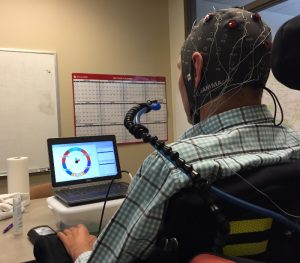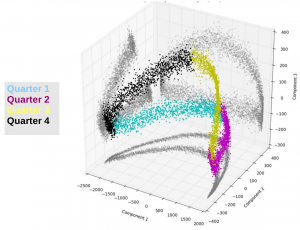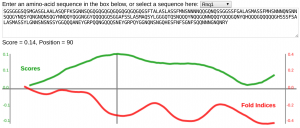This page contains brief descriptions of active research projects, some with links to pages with more details. Smaller or less active research projects appear as blog posts.
Brain-Computer Interfaces
 Brain-Computer Interfaces at CSU (1994-): Brain-computer interfaces (BCIs) are hardware and software systems that sample electroencephalogram (EEG) signals from electrodes placed on the scalp and extract patterns from EEG that indicate the mental activity being performed by the person. The long-term goal of this line of research is a new mode of communication for victims of diseases and injuries resulting in the loss of voluntary muscle control, such as amyotrophic lateral sclerosis (ALS), high-level spinal cord injuries or severe cerebral palsy. The autonomic and intellectual functions of such subjects continue to be active. This can result in a locked-in syndrome in which a person is unable to communicate to the outside world. The interpretation of information contained in EEG may lead to a new mode of communication with which subjects can communicate with their care givers or directly control devices such as televisions, wheel chairs, speech synthesizers and computers.
Brain-Computer Interfaces at CSU (1994-): Brain-computer interfaces (BCIs) are hardware and software systems that sample electroencephalogram (EEG) signals from electrodes placed on the scalp and extract patterns from EEG that indicate the mental activity being performed by the person. The long-term goal of this line of research is a new mode of communication for victims of diseases and injuries resulting in the loss of voluntary muscle control, such as amyotrophic lateral sclerosis (ALS), high-level spinal cord injuries or severe cerebral palsy. The autonomic and intellectual functions of such subjects continue to be active. This can result in a locked-in syndrome in which a person is unable to communicate to the outside world. The interpretation of information contained in EEG may lead to a new mode of communication with which subjects can communicate with their care givers or directly control devices such as televisions, wheel chairs, speech synthesizers and computers.
The main objectives of this project are to develop open-source software for on-line EEG analysis and brain-computer interfaces; compare signal quality and BCI performance of various EEG systems in users’ homes; develop new algorithms for identifying cognitive components in spontaneous EEG related to mental tasks as a basis for new BCI protocols; improve BCI reliability by allowing users to adapt through real-time feedback and by adapting the BCI algorithms using error-related EEG components; and experiment with interaction of two people using BCIs. Results are evaluated by the accuracy of EEG classification, the speed with which the classification can be performed, and the expense of the EEG system and of its maintenance and extendibility.
 EEG During July through December, 2016, I was on sabbatical leave, working with Walter Besio of the University of Rhode Island and CREMedical. Dr. Besio has developed a new EEG electrode consisting of three concentric rings. Signals from the three rings are combined in a pre-amplifier to produce spatially localized EEG recordings. He has shown that his tripolar electrodes, tEEG, reveal high frequency components that precede epileptic seizures. In a current collaboration, we are investigating benefits and limitations of tEEG electrodes used in brain-computer interfaces. Preliminary results show that P300 waves are more reliably detected with tEEG electrodes than with conventional electrodes. Example EEG data recorded from tripolar electrodes is available in this zip file.
EEG During July through December, 2016, I was on sabbatical leave, working with Walter Besio of the University of Rhode Island and CREMedical. Dr. Besio has developed a new EEG electrode consisting of three concentric rings. Signals from the three rings are combined in a pre-amplifier to produce spatially localized EEG recordings. He has shown that his tripolar electrodes, tEEG, reveal high frequency components that precede epileptic seizures. In a current collaboration, we are investigating benefits and limitations of tEEG electrodes used in brain-computer interfaces. Preliminary results show that P300 waves are more reliably detected with tEEG electrodes than with conventional electrodes. Example EEG data recorded from tripolar electrodes is available in this zip file.
This project started in 1992 when Dr. Jorge Aunon introduced Anderson to his early work with Keirn on brain-computer interfaces. our work has been supported by the National Science Foundation through awards 1065513, 0934499, 0542947, 0434351, 0208958, 9202100, and the Science Foundation of Ireland through an E.T.S Walton Award, 2007.
Reinforcement Learning
 Faster Reinforcement Learning After Pretraining or with Simultaneous Supervised Learning of Deep Networks (2015-): Reinforcement learning problems are ones for which correct actions must be learned by experience. Performance feedback is provided by an evaluative feedback, or reinforcement, that is based on the behavior of a system being controlled by the actions. Correct actions are not known before hand. Reinforcement learning algorithms have a reputation of being slow, partly because it can take a lot of interactions before performance is optimized. Another reason they are thought to be slow is that two kinds of problems must be solved: good actions must be discovered, and these actions must be associated with the state of the system. It is this second problem that supervised learning algorithms deal with. Deep neural networks are continuing to surpass state-of-the-art supervised algorithms in many domains. In this project, we are investigating the use of deep neural networks in a reinforcement learning framework. Deepmind, and others, have had considerable success with this approach. However, adding the long training times required for deep nets to the large number of interactions required for reinforcement learning problems can be problematic. We are investigating novel ways of pretraining the hidden layers of neural networks to learn representations that are useful in predicting next state from current state and action. Such information is available before any goal-oriented reinforcement values are introduced. We have found that for the pole-balancing problem a large reduction in reinforcement learning time resulting from pretraining deep Q-networks in this way. For more information, see
Faster Reinforcement Learning After Pretraining or with Simultaneous Supervised Learning of Deep Networks (2015-): Reinforcement learning problems are ones for which correct actions must be learned by experience. Performance feedback is provided by an evaluative feedback, or reinforcement, that is based on the behavior of a system being controlled by the actions. Correct actions are not known before hand. Reinforcement learning algorithms have a reputation of being slow, partly because it can take a lot of interactions before performance is optimized. Another reason they are thought to be slow is that two kinds of problems must be solved: good actions must be discovered, and these actions must be associated with the state of the system. It is this second problem that supervised learning algorithms deal with. Deep neural networks are continuing to surpass state-of-the-art supervised algorithms in many domains. In this project, we are investigating the use of deep neural networks in a reinforcement learning framework. Deepmind, and others, have had considerable success with this approach. However, adding the long training times required for deep nets to the large number of interactions required for reinforcement learning problems can be problematic. We are investigating novel ways of pretraining the hidden layers of neural networks to learn representations that are useful in predicting next state from current state and action. Such information is available before any goal-oriented reinforcement values are introduced. We have found that for the pole-balancing problem a large reduction in reinforcement learning time resulting from pretraining deep Q-networks in this way. For more information, see
- our 2015 paper
![[PDF]](http://www.cs.colostate.edu/~anderson/wp/wp-content/uploads/2017/06/pdf.png) and others on the Publications page,
and others on the Publications page, - a recent blog entry with animations, and
- a video of a 2016 talk at Brown University.
Our research in reinforcement learning started in the 1980’s when Anderson was Ph.D. student, working with Andy Barto and Rich Sutton. This work has been supported by the National Science Foundation through awards 0245291, 9804747, 9401249, and 9212191.
Climate Informatics
 Climate Informatics (2015-): Atmospheric data sets often consist of multiple time series with unknown, complex interrelationships. In this project we seek to explore what kind of interrelationships can be discovered in climate data by applying the framework of artificial neural networks. As a first application we look at establishing relationships between top of atmosphere radiative flux and air/surface temperatures. This is an important application, since a thorough understanding of those relationships is essential for understanding the effect of CO2-induced warming on the Earth’s energy balance and future climate. We describe the basic idea, first observations and plans for future work. For more information, See our 2015 paper
Climate Informatics (2015-): Atmospheric data sets often consist of multiple time series with unknown, complex interrelationships. In this project we seek to explore what kind of interrelationships can be discovered in climate data by applying the framework of artificial neural networks. As a first application we look at establishing relationships between top of atmosphere radiative flux and air/surface temperatures. This is an important application, since a thorough understanding of those relationships is essential for understanding the effect of CO2-induced warming on the Earth’s energy balance and future climate. We describe the basic idea, first observations and plans for future work. For more information, See our 2015 paper ![[PDF]](http://www.cs.colostate.edu/~anderson/wp/wp-content/uploads/2017/06/pdf.png) and poster
and poster ![[PDF]](http://www.cs.colostate.edu/~anderson/wp/wp-content/uploads/2017/06/pdf.png) . We are also excited to be part of an NSF AI Institute called NSF AI Institute for Research on Trustworthy AI in Weather, Climate, and Coastal Oceanography (AI2ES). The CSU work on this project and others related to AI in atmospheric science is summarized at this Cooperative Institute for Research in the Atmosphere (CIRA) website. We contributed to a 2019 paper Viewing Forced Climate Patterns Through an AI Lens.
. We are also excited to be part of an NSF AI Institute called NSF AI Institute for Research on Trustworthy AI in Weather, Climate, and Coastal Oceanography (AI2ES). The CSU work on this project and others related to AI in atmospheric science is summarized at this Cooperative Institute for Research in the Atmosphere (CIRA) website. We contributed to a 2019 paper Viewing Forced Climate Patterns Through an AI Lens.
Bioinformatics
 Protein Aggregation Propensity (2013-): Numerous proteins contain domains that are enriched in glutamine and asparagine residues, and aggregation of some of these proteins has been linked to both prion formation in yeast and a number of human diseases. Unfortunately, predicting whether a given glutamine/asparagine-rich protein will aggregate has proven difficult. Here we describe a recently developed algorithm designed to predict the aggregation propensity of glutamine/asparagine-rich proteins. We discuss the basis for the algorithm, its limitations, and usage of recently developed online javascript implementation and downloadable versions of the algorithm.
Protein Aggregation Propensity (2013-): Numerous proteins contain domains that are enriched in glutamine and asparagine residues, and aggregation of some of these proteins has been linked to both prion formation in yeast and a number of human diseases. Unfortunately, predicting whether a given glutamine/asparagine-rich protein will aggregate has proven difficult. Here we describe a recently developed algorithm designed to predict the aggregation propensity of glutamine/asparagine-rich proteins. We discuss the basis for the algorithm, its limitations, and usage of recently developed online javascript implementation and downloadable versions of the algorithm.